Ever wondered about the different types of tonometer tip covers and what sets them apart? You’re not alone. Whether you’re an experienced optometrist, a budding vision researcher, or a curious patient, we’ve got the insider scoop on all things tonometer tip covers. We’re delving deep into sleeved and unsleeved tips – allowing you to make informed choices and gain a deeper understanding of this essential tool within ophthalmology.
“Understanding your tools is the first step to delivering the best patient care.”
We know your time is valuable, so we’ve broken down this guide into several key sections:
The safety of both the medical practitioner and the patient should be the top priority in any clinical environment, hence the critical necessity of using a tonometer pen with a tip cover.
These tip covers, often containing latex, act as a barrier against possible contamination and infection. This caution is essential as the use of a tonometer pen without a tip cover may inadvertently cause significant harm, such as eye diseases or infections. Particularly when we consider the immediate proximity of these tools to the sensitive ocular area.
On the other hand, correct usage of tonometer tip covers is also paramount. For instance, one has to ensure the seal of the cover is aptly positioned. This guarantees not only the safety of the application but also the accuracy of the measurements, which is equally crucial.
Let’s turn our gaze to the accessibility and variety of tonometer tip covers. Automated Ophthalmics, for instance, offers a wide range of tonometer tip covers. These are compatible with highly popular tonometers like Tono-Pen and Accupen. The covers come in different packs, including bulk bags and individually wrapped packages, catering to diverse requirements.
Disposable tonometer tips are another alternative gaining recommendation in clinical practice. Their predominant advantage lies in their efficiency to eliminate cross-infection risks. As a matter of fact, recent studies are beginning to reveal their accuracy and reliability, showing a comparable performance to the traditional Goldmann tonometry.
An equally relevant point is the urgent necessity of regular inspection and maintenance of tonometer tips. Such routine checks, preferably at the slit lamp, help to identify and replace damaged tips promptly. This approach ensures the tips are always in optimal conditions, thereby maintaining their effectiveness and avoiding potential health risks.
Lastly, it’s worth mentioning that medical practitioners can use disposable prism or silicone tonometer shields. These can serve as an excellent alternative to frequent chemical disinfection of the tonometer prism, effectively preventing the spread of infections. After all, the aim is to provide quality eye care while ensuring the safety of everyone involved.
Gaining a comprehensive understanding of tonometer sleeved tip covers provides you with crucial context on how these devices function. These specialized accessories are designed to fit snugly over the tip of your tonometer, thus forming a protective layer to shield it from direct contact with your patient’s eye.
Essentially, a sleeved tonometer tip cover is designed to be an effective barrier that safeguards against the spread of infection by significantly lowering the likelihood of cross-contamination. The protection offered by these covers emphasizes their crucial role in ensuring safe tonometry procedures.
These disposable, fitted sleeves are highly recommended for use in clinical settings, owing to the accuracy and consistency they maintain in actual field conditions. Reminiscent of the reliable Goldmann tonometry method, these sleeved covers merge convenience with accuracy, making a strong case for their routine use.
However, it’s important to take note of the device manufacturers’ guidelines regarding their usage period. The rule of thumb generally suggested is to replace the sleeved tip covers roughly every two years—or after 100 disinfection cycles with a solution of 1:10 dilute bleach. This practice ensures the continued high performance of the tonometer prisms and helps maintain an environment that safeguards the health of each patient.
In the realm of eye care, deciding on the right tonometer is crucial. These dependable instruments, vital for gauging intraocular pressure, can be selected based on a few key considerations. Here’s a user-directed guide to unravel those principles, making the buying decision a well-informed one.
Firstly, you should consider accuracy. The entire purpose of a tonometer centers on its ability to obtain precise measurements. Research suggests that disposable tonometer tips demonstrate notable accuracy and reliability, comparable to the Goldmann standard. Their diligent use removes the risk of cross-contamination, ensuring a safe and reliable clinical experience.
Next, take into account the type and style of tonometer. Two common types are available: Tono-Pen and Accupen. Both come with the option of sleeved tip covers, contributing to a hygienic examination procedure. All tonometer styles offer considerable advantages, so your choice should align with the specific needs of your practice.
Another factor to remember is ease of use. Tonometers with intuitive designs and straightforward operating procedures can save time and reduce the potential for user error. Always prioritize models that streamline the examination process, allowing you to provide a seamless service to your patients.
The availability and practicality of disposable covers also need to be considered. Tonometer tip covers, such as those available from Automated Ophthalmics, add another layer of infection control. They are available in bulk bags or individually wrapped packages – choose what best suits your clinical workflow.
As with any ophthalmic practice or product, there are both advantages and disadvantages that come with tonometer tip covers. Let’s delve deeper into these aspects to give you a balanced perspective.
| Factor | Sleeved Tonometer Tip Covers | Un-Sleeved Tonometer Tip Covers |
|---|---|---|
| Risk of Cross-Infections | Low (when used correctly) | Low (when used correctly) |
| Packaging Options | Available in bulk bags and individually wrapped packages | Primarily bulk bags |
| Compatibility with Tonometers | Compatible with popular tonometers like Tono-Pen and Accupen | Compatible with common tonometers, may not fit all models |
| Disinfection Requirements | None, disposable after single use | Requires disinfection after each use |
| Potential for Patient Harm | Low, if checking for damage before applanation | Higher, if not disinfected properly |
On the positive side, tonometer tip covers are well known for their role in infection prevention. These protective shields form a barrier between the tonometer tip and the patient’s eye, reducing the risk of transmission of infections between patients. This is particularly crucial in clinical environments where multiple patients are tested using the same tonometer device.
A notable case for using these covers is the rise of disposable prism or silicone tonometer shields. These are gaining popularity due to their ease of use and added convenience, eliminating the need for frequent, time-consuming disinfection processes. Studies evidencing the reliability and accuracy of these disposable shields, compared to conventional Goldmann tonometry, further validates their adoption.
However, tonometer tip covers are not without their downsides. Firstly, the associated costs of using disposable covers can add up, particularly in busy eye care practices. Secondly, while these covers are undeniably effective in preventing the spread of infection, the resultant waste could pose an environmental concern if not disposed of properly.
Yet, it’s important to note that the pros of utilizing these protective shields evidently outweigh their cons, particularly when the overall objective is patient safety and care. By always considering the specific needs, you can successfully navigate these challenges and optimize the benefits of tonometry procedures for your patients.
While performing tonometry, the specific challenge you may encounter relates to acquiring accurate intraocular pressure (IOP) measurements; the cornerstone of effective glaucoma management. Thankfully, recent advancements have given birth to a promising solution: Excursion tonometry.
Excursion tonometry is a pioneering technique designed to gauge the IOP-lowering effect of the Mean Pulsation Dynamic (MPD). Its unique ability to enable direct access to the cornea for measurement distinguishes it from traditional methods. Recent clinical observations testify to the precision of this method, demonstrating its remarkable reliability in delivering results that can strongly compete with the standards set by Goldmann tonometry. The process can be optimized by thoughtful consideration of factors such as the pressure applied and effective engagement with the cornea, both of which contribute substantially to the accuracy of IOP assessments.
A noteworthy element of the Excursion tonometry setup lies in the tonometer tip covers. These are essential accessories provided by trusted suppliers such as Automated Ophthalmics, which offer both sleeved and un-sleeved options compatible with popular tonometers like Tono-Pen and Accupen. However, using tonometer tip covers comes with its own challenges and benefits. In view of eliminating cross-infection risks, clinical practices are increasingly embracing the use of disposable tip covers.
Carefully navigating these procedures, along with disciplined inspection and maintenance of tonometer tip covers, can significantly elevate the efficacy and safety of your tonometry practices. In this continuous pursuit of excellence, a conscious effort to regularly update your skillset and knowledge can render you effective in delivering the best eye care possible, one patient at a time.
At the heart of maximized tonometry effectiveness is the consistent and thorough inspection of tonometer tips. Ideally, these inspections should be conducted routinely at the slit lamp, as doing so helps prevent patient harm by identifying and swiftly replacing tips that display any form of damage. The importance of this practice escalates further when using reusable tonometers; prior to applanation, the tip must be meticulously checked for damage.
Disposable tonometer tips have been widely recommended and increased in popularity in modern clinical practice, and for good reason. By using these disposable tips, healthcare professionals can essentially eliminate the risk of cross-infections associated with tonometers. The fear of inaccuracy or reduced reliability with these disposable tips has been laid to rest by recent studies, which have convincingly demonstrated their comparable reliability and accuracy to established standards such as Goldmann tonometry.
Another critical aspect of maximizing the efficacy of tonometry procedures resides in the correct usage of tonometer tip covers. Using tonometer tip covers is no guarantee of success; the onus resides in ensuring the seal is in the correct position. This seemingly minor detail plays a significant role in achieving accurate readings.
Briefly touching upon the subject of disinfection, two segments of a study examined different disinfection methods for tonometer tips. The first segment involved three sets of experiments with various disinfection methods. The second segment, on the other hand, involved several experiments using different soaking methods specific to tonometer tips. Findings from this study highlight the need for continued knowledge upgrade for all healthcare professionals involved in tonometry procedures.
Tonometry, at its best, involves a blend of regular inspection, detailed maintenance, the correct use of tools such as tip covers, and an ongoing commitment to knowledge upgrades. With reliable suppliers like Automated Ophthalmics offering both sleeved and unsleeved tonometer tip covers that are compatible with popular tonometers such as Tono-Pen and Accupen, it is quite achievable to do your part in fostering a safer, more reliable future for tonometry.
Disposable tonometer tip covers, also known as tonometer shields, are recommended to reduce the risk of cross-infections. Recent studies show their use is reliable and as accurate as traditional Goldmann tonometry.
Various types of tip covers exist, like bulk bags and individually wrapped packages. Finding the right type depends on factors such as your practice environment and specific tonometry needs.
To guarantee accurate readings, the seal of the tonometer tip cover must be properly positioned. Incorrect positioning could affect data accuracy during tonometry procedures.
Using a tonometer pen without a proper tip cover can risk cross-contamination that may result in eye infections or diseases. Utilization of a cover is a critical aspect of maintaining hygiene and safety during tonometry.
Disposable prism or silicone tonometer shields can be utilized to prevent the spread of infection, offering a convenient alternative to frequent tonometer prism disinfection.
Yes, tonometer pens are usually latex-free but even so, they should not be used without a tip cover to ensure the safety and protection against infection.
Tonometer tips should be routinely inspected at the slit lamp, and any damaged tips should be replaced immediately to maintain the integrity and accuracy of tonometry procedures.
In conclusion, keeping up with the maintenance of tonometer tips – inspecting them often, replacing any damaged ones, and ensuring the correct use of tonometer tip covers – is utterly important in clinical practice. Only by adhering to these essential steps can we preserve the integrity of tonometry measurements and continue to provide accurate and safe eye health evaluations. It’s not just about preventing cross-infections; it is equally about preserving the quality and reliability of the data we rely on to treat vision impairments effectively and promote better ocular health.
VISIT OUR SHOP
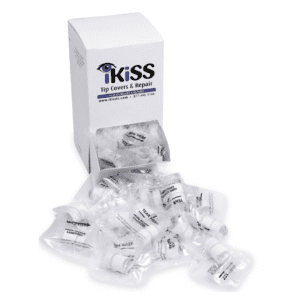
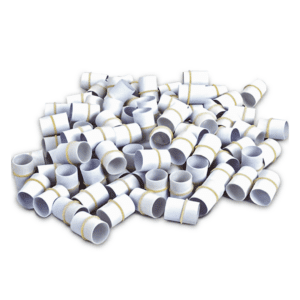
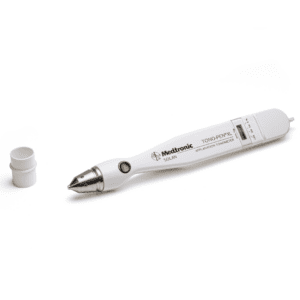
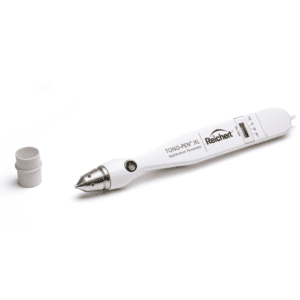
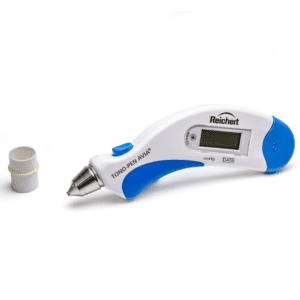
iKiSS is the go-to provider for top-quality refurbished Tono-Pen® Tonometers, Tono-Pen AVIA® Tonometers, Slit Lamps, and Phoropters, offering substantial savings of up to 40%.